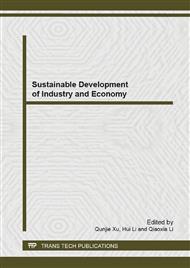p.958
p.963
p.967
p.971
p.976
p.980
p.986
p.991
p.997
Path Selection of Low-Carbon Traffic Development in Qingdao
Abstract:
By the use of the low-carbon traffic model, quantitatively analyzed the current situation of carbon emissions in different modes of urban traffic, this paper emphasized on studying the low-carbon development paths of Qingdao transportation. The results show that, the proportion of CO2 from private cars is the most highest; the increasing number of private cars, and the reduce use of public transport, is the main reason for the increase urban traffic emissions. Through the study of traffic structure, transportation and energy consumption characteristics of Qingdao, low-carbon development paths of Qingdao transportation are proposed from the aspects of urban space, traffic structure, residents travel mode and energy-saving technology.
Info:
Periodical:
Pages:
976-979
Citation:
Online since:
December 2013
Authors:
Price:
Сopyright:
© 2014 Trans Tech Publications Ltd. All Rights Reserved
Share:
Citation:


